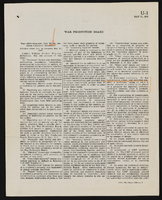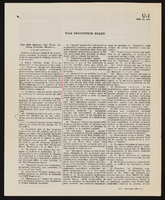Search the Special Collections and Archives Portal
Search Results

Film transparency of a ghost town, Delamar, Nevada, 1956
Date
1956
Archival Collection
Description
Some of the abandonded buildings in Delamar, Nevada. A tailing pile from one of the mines is visible in the center of the photograph. A stone structure is visible on the right side of the photograph. Delamar, Nevada, nicknamed The Widowmaker, is a ghost town in central eastern Nevada, USA along the east side of the Delamar Valley. During its heyday, primarily between 1895 and 1900, it produced $13.5 million in gold. In 1889, prospectors John Ferguson and Joseph Sharp discovered gold around Monkeywrench Wash. A mining camp was then born west of the Monkeywrench Mine. It was called Ferguson. In April 1894, Captain Joseph Raphael De Lamar bought most of the important mines in the area and renamed the Ferguson camp as Delamar. In the same year, a newspaper called the Delamar Lode began publication and a post office was opened. Soon, the new settlement boasted more than 1,500 residents, a hospital, an opera house, churches, a school, several businesses and saloons. Most buildings were made of native rock. By 1896, the Delamar mill was handling up to 260 tons of ore daily. Water for the camp was pumped from a well in Meadow Valley Wash, some twelve miles away. Supplies and materials traveled even further, by mule team over mountainous terrain from the railroad head at Milford, Utah, which was 150 miles from Delamar. Silicosis The gold in the Delamar mines was embedded in quartzite which when crushed created a fine dust. Miners breathing the dust often developed silicosis and the town became known as a "widow-maker." Many ruins now stand semi-intact in the Delamar ghost town region. Foundations can easily be seen from adjacent hills. There are two graveyards, which have been vandalized. The area is honeycombed with mines and mineshafts, but in recent years the main shaft has been blasted closed. Wild horses roam the area. The nearby dry lake is known to pilots as Texas Lake because its outline resembles the state of Texas.
Image
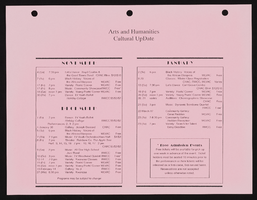
Alpha Kappa Alpha Sorority, Theta Theta Omega Chapter arts and humanities committee reports
Date
2000-01-08 to 2000-12-13
Archival Collection
Description
From the Alpha Kappa Alpha Sorority, Incorporated, Theta Theta Omega Chapter Records (MS-01014) -- Chapter records file.
Text
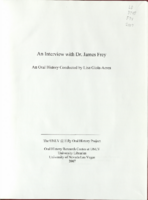
Transcript of interview with Dr. James Frey by Lisa Gioia-Acres, February 14, 2007
Date
2007-02-14
Archival Collection
Description
James Frey was born in Eureka, South Dakota, in 1941. His father worked in creamery and his mother was a registered nurse. When James was nine, the family,including his twin sister, relocated in Sioux Falls where his dad was plant manager for a dairy. He joined the YMCA in the fourth grade and ended up working for them until James attended Augustana College in Sioux Falls, graduating with a major in sociology and a minor in history. After graduation, he worked for three years at the YMCA in Sioux Falls as program director. He earned his master's degree in sociology at the University of Iowa in two years, and was hired at the YMCA in Whittier, California, where he worked for three years. While working in Whittier, James was offered a fellowship to Washington State University in Pullman. He committed to completing his doctorate in three years, and while still working on his dissertation began sending out applications. He sent one to UNLV and arrived in Las Vegas for an interview in 1974. James was hired as assistant professor of sociology at UNLV, and immediately established a survey center at the university. He also converted his dissertation into a book length manuscript and had it published, followed by other books and articles over the years. He conducted a survey on a very high-profile political race between Sheriff Ralph Lamb and his opponent, John McCarthy, which led to work for the State of Nevada, Yucca Mountain, and other entities. The survey program was eventually named the Cannon Center for Survey Research, after Senator Howard Cannon. In the course of his career, James was tenured, taught in London under a university sponsored program, spent a sabbatical in Washington, D.C., doing research, taught several classes, and served seven years as dean. He has detailed memories of the contributions of several university presidents, including Brock Dixon, Pat Goodall, Robert Maxson, Kenny Guinn, and Carol Harter. Today, Dr. James Frey and his wife of over thirty years, Carol, are both retired. He has made a smooth transition to president of his Rotary Club, Chairman of the Nevada Humanities group, and spectator at UNLV basketball and football games. He and his wife plan to stay in Las Vegas, close to their son and friends and neighbors they know and love.
Text
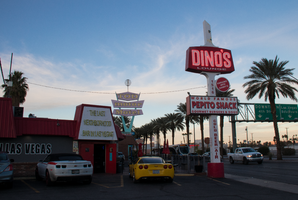
Photographs of Dino's Lounge sign, Las Vegas (Nev.), February 19, 2017
Date
2017-02-19
2017-08-11
Archival Collection
Description
Dino's Lounge sits at 1516 South Las Vegas Boulevard. The dive bar has been in operation since 1962. Information about the sign is available in the Southern Nevada Neon Survey Data Sheet.
Site address: 1516 S Las Vegas Blvd
Sign owner: Kristin Bartolo
Sign details: This location was originally constructed in 1957. Opened as Ringside Liquors by Eddie Trascher. Trascher sold the property to Rinaldo Dean "Dino" Bartolomucci in 1962. Bartolomucci Renamed it "Dino's". Bartolomucci sold cars in california, moved to Las Vegas in the 1950's. "Dino's" is now owned by his granddaughter Kristin Bartolo.
Sign condition: 4 out of 5, it still lights up brightly at night and has bright paint colors.
Sign form: Pylon as well as signage on the building.
Sign-specific description: Sign on building green cover filtered neon, with a script style design for the name. Road pylon contains skeletal neon with red and white design also stating their name "Dino's" in the same font as the sign on the building. This pylon has a white base that extends out of the main red rectangle portion of the sign. Also below their logo is a back lit plastic sign.
Sign - type of display: Neon (skeletal on roadside sign and encased on building) and Plastic Backlit sign
Sign - media: Steel and plastic.
Sign - non-neon treatments: Plastic back lit portion
Sign environment: This is located downtown just a few blocks south of Fremont, next to Tod Motor Motel.
Sign - date of installation: 1963
Sign - thematic influences: This sign shows 50's/60's trend with the base of the sign extending out of the main worded portion of the sign. That trend is very common among many other signs across the valley from the same era.
Survey - research locations: Dino's website http://dinoslv.com/new/, Recorder's office, Assessor's office, Dino's site visit and discussion with owner Kristin.
Survey - research notes: This location is .35 acres and was constructed 1957. The Dino's website contains an archive of images of their bar and owners from the last 50 years, and some of the images show older photos of their sign.
Surveyor: Wyatt Currie-Diamond
Survey - date completed: 2017-08-11
Sign keywords: Neon; Plastic; Backlit; Steel; Pole sign
Site address: 1516 S Las Vegas Blvd
Sign owner: Kristin Bartolo
Sign details: This location was originally constructed in 1957. Opened as Ringside Liquors by Eddie Trascher. Trascher sold the property to Rinaldo Dean "Dino" Bartolomucci in 1962. Bartolomucci Renamed it "Dino's". Bartolomucci sold cars in california, moved to Las Vegas in the 1950's. "Dino's" is now owned by his granddaughter Kristin Bartolo.
Sign condition: 4 out of 5, it still lights up brightly at night and has bright paint colors.
Sign form: Pylon as well as signage on the building.
Sign-specific description: Sign on building green cover filtered neon, with a script style design for the name. Road pylon contains skeletal neon with red and white design also stating their name "Dino's" in the same font as the sign on the building. This pylon has a white base that extends out of the main red rectangle portion of the sign. Also below their logo is a back lit plastic sign.
Sign - type of display: Neon (skeletal on roadside sign and encased on building) and Plastic Backlit sign
Sign - media: Steel and plastic.
Sign - non-neon treatments: Plastic back lit portion
Sign environment: This is located downtown just a few blocks south of Fremont, next to Tod Motor Motel.
Sign - date of installation: 1963
Sign - thematic influences: This sign shows 50's/60's trend with the base of the sign extending out of the main worded portion of the sign. That trend is very common among many other signs across the valley from the same era.
Survey - research locations: Dino's website http://dinoslv.com/new/, Recorder's office, Assessor's office, Dino's site visit and discussion with owner Kristin.
Survey - research notes: This location is .35 acres and was constructed 1957. The Dino's website contains an archive of images of their bar and owners from the last 50 years, and some of the images show older photos of their sign.
Surveyor: Wyatt Currie-Diamond
Survey - date completed: 2017-08-11
Sign keywords: Neon; Plastic; Backlit; Steel; Pole sign
Mixed Content
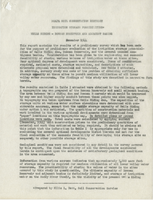
Report by Moapa Soil Conservation District on irrigation storage possibilities of Wells Siding, Bowman Reservoir, and adjacent basins, December 1944
Date
1944-12
Archival Collection
Description
Results of a preliminary survey of irrigation storage potential of Wells Siding, Bowman Reservoir and other nearby sites.
Text

Jamey Stillings Artist Statement: "Changing Perspectives: The Evolution of Ivanpah Solar," 2015
Date
1905-07-07
Archival Collection
Description
Artist Statement
Text
Pagination
Refine my results
Content Type
Creator or Contributor
Subject
Archival Collection
Digital Project
Resource Type
Year
Material Type
Place
Language
Records Classification


